From my husband Tom:
Susan is temporarily handing over the keys to the blog post to me. I’ll see to it that you continue to receive your regular dose of fabric collage content by revisiting my favorite posts. So for three weeks here at the end of Summer, I’ll show off some of Susan’s quilts. You may have seen them before, but like all art, another viewing may reveal things you hadn’t or weren’t ready to see before. I hope they inspire you.
Today’s quilt, “Dixie Dingo Dreaming,” is a portrait of her beloved dog Pippin (yes, named after the Lord of the Rings character). Many of Susan’s quilts are intensely personal. In this case, the quilt now memorializes our dearly departed pup. As we say in the post below, “serious” art tends to avoid the personal, the sentimental, as though those feelings cannot possibly have any message of value to pass on. This isn’t true, of course. This quilt continues to speak to most who see it. The extended story connected to its construction, as you will read, only adds to the meaning viewers take from the quilt.
The first post of “Dixie Dingo Dreaming” has been updated a couple times, adding even more technical and personal information to the original.
Susan will be back soon. We all encounter periods in our lives that are more challenging than others. Physical or mental illness, professional setbacks, natural disasters, and so on. This is part and parcel of being human. We recover, given time, enough to rediscover joy.
Susan is undergoing one of those periods, having lost her mother and father within five months of each other. Her way of rediscovering joy is spending time in her studio working on her next spectacular fabric collage quilt, which has a deadline of early September. Creativity is her balm. So while she replenishes her spirit we can enjoy her past quilts and look forward to the completion of her next work of art.
Susan has also encouraged me to share with you a passion of mine: sea kayaking. I enjoy the sport for so many reasons. Increasingly, I have found the social aspect of paddling with friends most beneficial. Then there is the restful and curative power of being in nature: the ocean, the islands, the wildlife. And of course it is a physical activity to offset the many hours I spend in front of a computer screen. In the next few weeks I’ll drop a sampling of videos I have produced around my adventures.
—Tom
Quilt Stories: “Dixie Dingo Dreaming” (Slideshow Update)
Original Update from June 17, 2017
“Dixie Dingo Dreaming,” the quilt of my dearly departed dog, Pippin, remains one of my favorites. Recently I have had a few students using Australian Aboriginal print fabrics like those in “Dixie Dingo Dreaming,” and lots of students doing portraits of their pets, both of which bring this quilt to mind. It occurs to me that others might like to see how I used these fabrics, with their particular style and motifs, in my quilt. So in keeping with the goal of updating previous blog posts with video, I offer the following.
I don’t suggest that everyone use Aboriginal prints for every fabric collage quilt. In fact, I don’t suggest any style of fabric for every project (okay, maybe printed batiks). Instead, when students are having trouble getting over the hump of choosing which fabrics to start with, I find myself asking them to tell me about their subject. In the case of pets, I may ask them: what are their personalities? Where do they like to hang out? What are their favorite things to do? But most importantly, is there a story behind the subject?
The original blog post (below) gives the whole story of “Dixie Dingo Dreaming,” explaining why I chose the Australian Aboriginal prints in the first place. The new video meanwhile shows how I used the unique features of those Aboriginal fabrics to create the image.
Original Post from April 9, 2016
Sometimes I wonder if I’m a “serious” artist. I mean, I don’t really worry about it, but it crosses my mind. Anyway, do I really want or need to be a “serious” artist?
And what is “serious” art anyway? I suppose it’s art with a purpose, with an important message, or with a revolutionary way of viewing the world. It tackles important social, political, or philosophical topics. It’s cerebral rather than emotional. It makes you think rather than feel.
Obviously, I don’t believe a word of it. Art can’t be and isn’t bound by such rigid and passionless beliefs. It’s possible and desirable for art to both provoke thought and evoke emotion.
Still, the one thing considered most “unserious” in art may be sentimentality, while its opposite, irony, is nearly worshipped.
By this one measure, then, I am certainly not a “serious” artist. Sentiment literally means feeling. I’m all about feeling, and that trait is reflected, I think, in my quilts, especially those of my family members.

Pippin
“Dixie Dingo Dreaming,” the quilt of my dog, Pippin, is a good example. I didn’t create this quilt in order to make a statement. It is simply a portrait in which I hoped to capture the likeness and character of my beloved pet.
Pippin was a stray in Georgia before being rescued. When I described her to an employee at the local feed and farm store, she replied, “Oh, she’s a Dixie dingo, then.” I’d never heard of them, but a quick Google search and, sure enough, there she was, the native canine of the Americas. Later we came to suspect she had more than a little cattle dog in her, too, but the dingo description followed her for life.
Like many of my quilts, this one had an extended gestation period. I always seem to be setting fabric aside for future quilts. Once I had “dingo” in my mind for Pippin, I made the connection to Australia and to Aboriginal prints. I decided when I did make a quilt of her I would use all Aboriginal-design themed fabrics. For several years, everywhere I went, I was on the lookout for Australian fabrics.
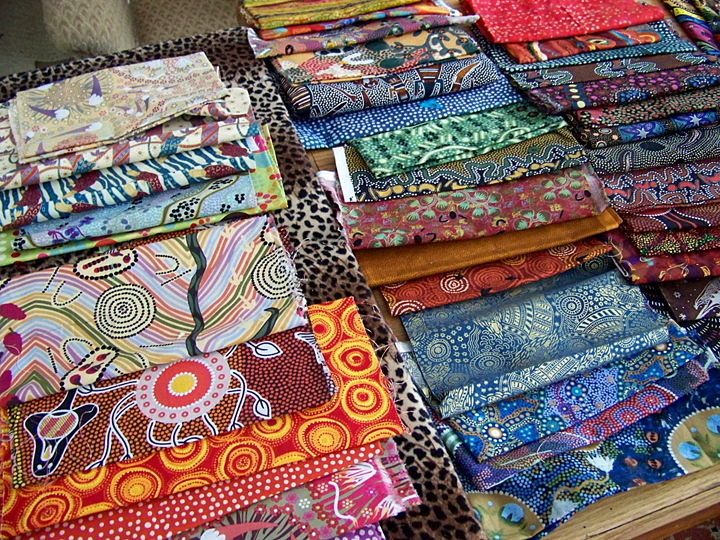
Despite her obvious beauty (!) making a quilt of Pippin wasn’t a priority. Pippin was deep into middle-age when I decided to enter a quilt in the 2011 Houston International Quilt Festival. The theme for that year’s special exhibit was “Good for You.” This particular competition required that the quilt be a new work. It didn’t take long to come up with a justification for how a portrait of Pippin would fit in the “Good for You” theme. Here’s the description that accompanied my entry:
Pets, like our dog Pippin, enrich our lives. The fact that she is not of a breed recognized by the American Kennel Club does not dismay Pippin any more than it does us. She is plainly satisfied to be partly or wholly (who knows for sure?) dixie dingo, the wild dog of the Americas. She reminds us to be happy with who and where we are. Sitting in the sun is an opportunity to practice her philosophy of living in the moment. While correct posture is an important habit to cultivate, it is sometimes preferable, indeed sometimes necessary, to slouch. Simplicity is her touchstone: warmth, food, and affection are all that are really needed. Though on her short list of indulgent behaviors are: begging for dog biscuits, snitching compost scraps, fighting strange dogs, and rolling in anything rotten (either animal or vegetable, it matters not, nor is it always clear). The only thing better than lying in the sun is: sleeping in the sun, of course. Even sitting up her eyes droop and she snoozes, though it is better obviously to stretch out, turning from belly to side to back in order to ensure even distribution of the sun’s rays. Sometimes, when she is lying belly up with legs in the air, her tail will wag, though we have not moved or spoken. Is there any clearer indication that she is happy? Is there any clearer invitation to be happy ourselves?
Making “Dixie Dingo Dreaming”
Pippin had two poses that were typical of her. One was lying with her paws crossed in front of her. This dainty pose belied her ferocious demeanor whenever strangers came to the door, which was less Lady and more Cujo (think bared teeth and flecks of foam). The other pose we later learned is called the cattle-dog slouch. She would sit this way when very relaxed, rear legs splayed out, in a not-very-ladylike way.
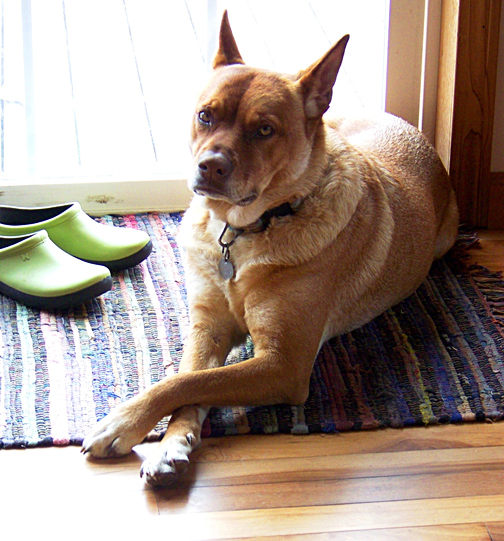
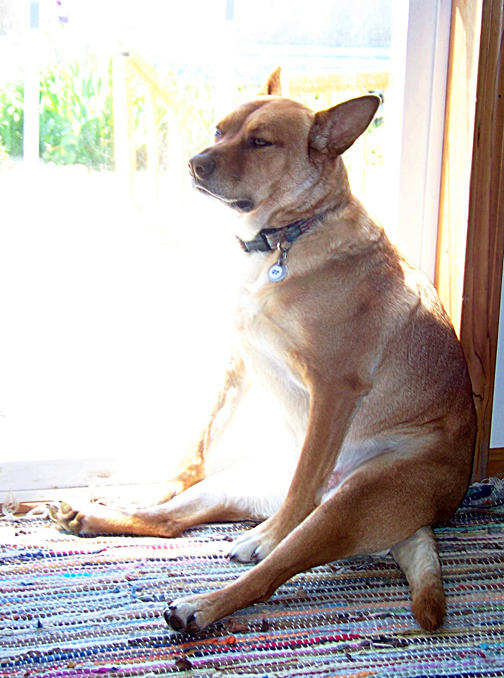
After reviewing my photos I chose the second pose. It was more dynamic (despite the sleepiness evident in her body) and more uniquely her. So as I explained in a previous post, it was time to make a pattern and transfer it to a backing fabric. I wanted her to be life size, so I measured her sitting up and figured out how much to enlarge my outline drawing. The full-size pattern is tiled together from about twelve separate pieces of paper. In this case it was easier to print it out from the computer than run to the copy center.
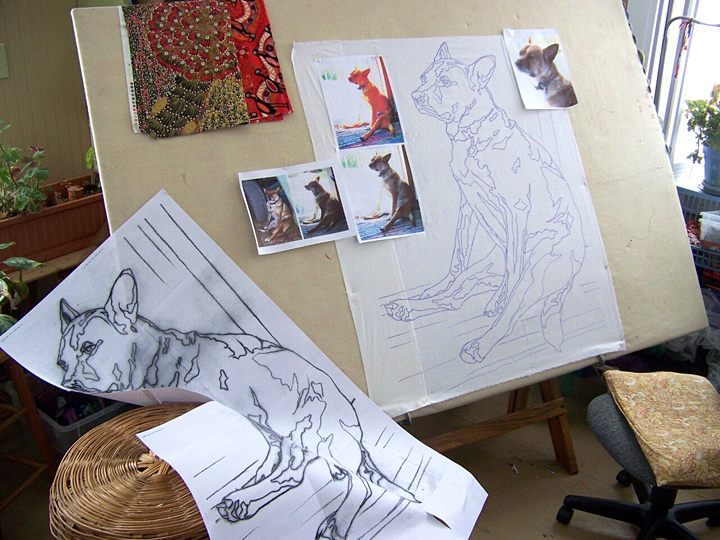
As is my habit, I started with her face. That’s the most interesting part for me, and provides an anchor for me to work out from. If I’m happy with the face, the rest seems easier somehow.
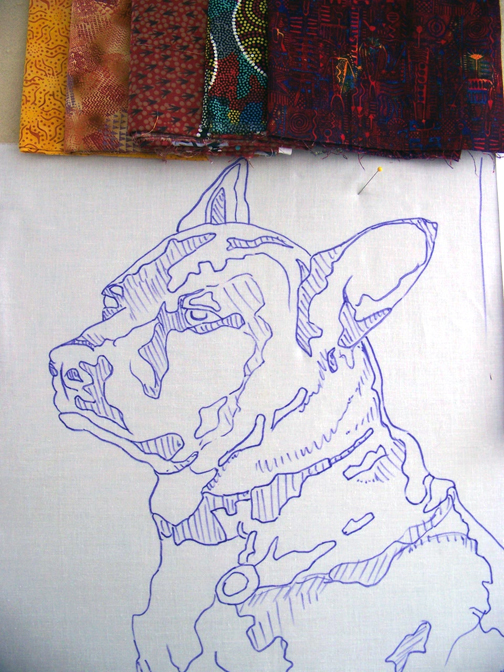
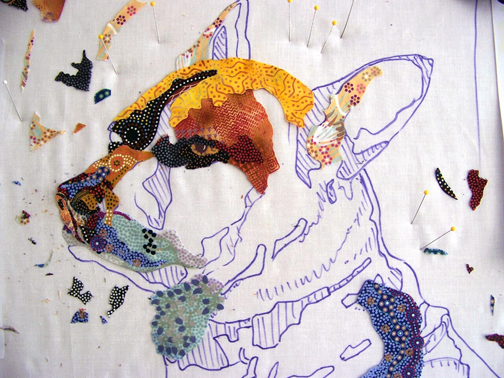
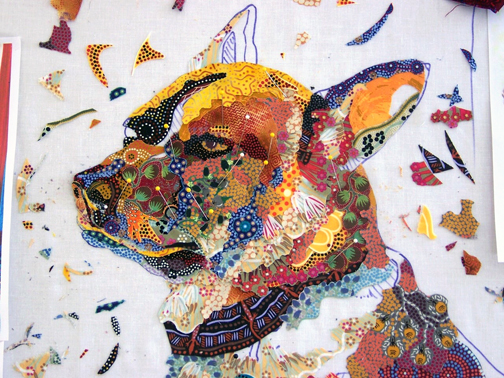
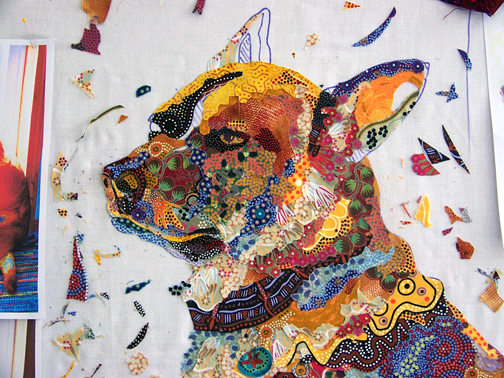
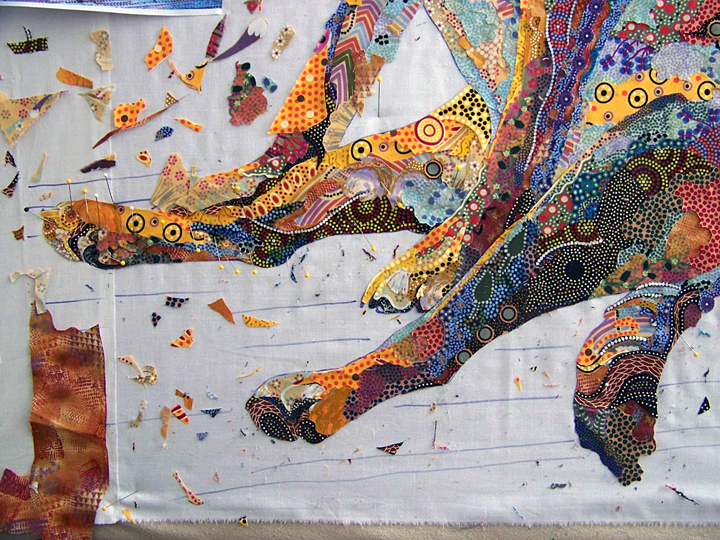
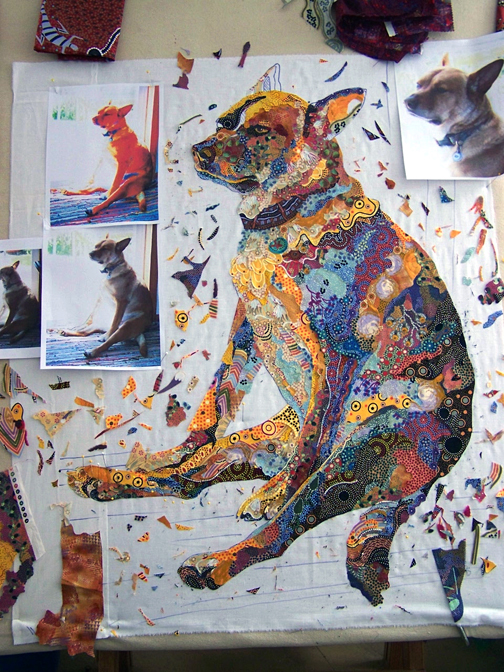
Once I had Pippin almost done. I started to think about backgrounds. At this point, it occurred to me to check the requirements for entry into the “Good for You” competition. Good thing I did. The minimum size for inclusion was 4 x 4 feet. It was lucky I had made Pippin as large as I did, but because she is mostly vertical in format, it meant I would have some width to make up.
Since the photo was of her sitting in the sun, it made sense to include a sun in the composition. In my research, however, I discovered Australian Aborigines didn’t seem to have a symbol for the sun. That would have been the obvious solution. Instead, and luckily, I was forced to create my own sun.

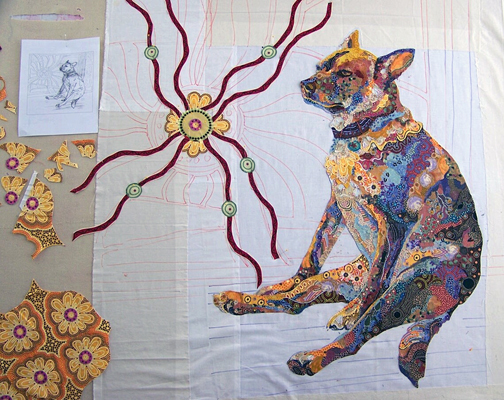
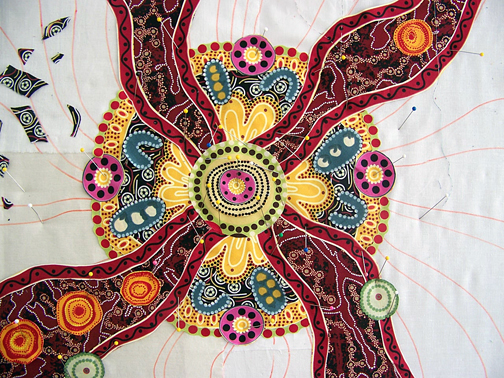
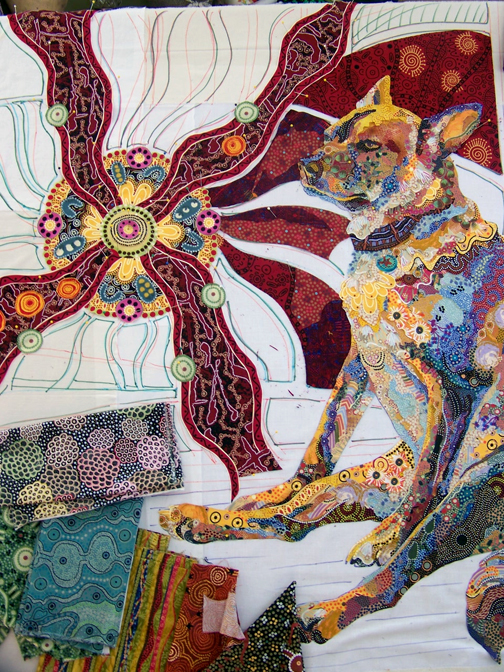
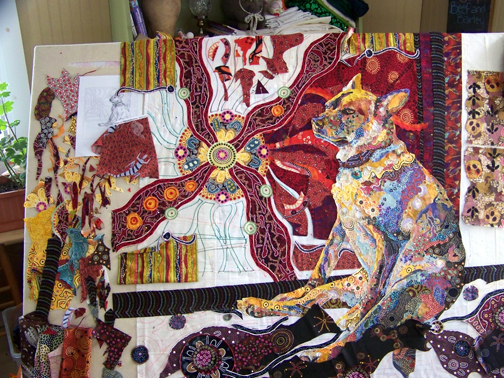
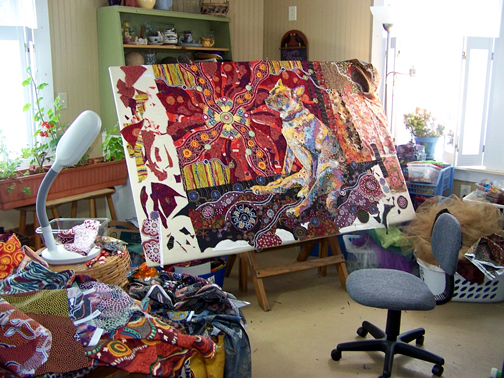
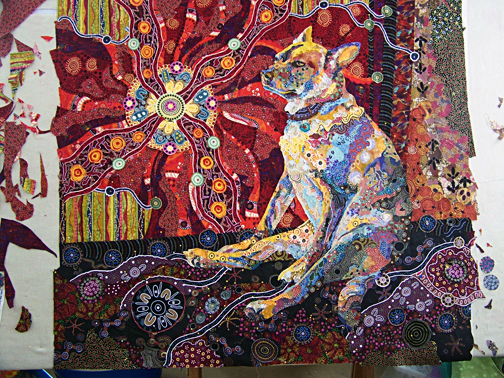
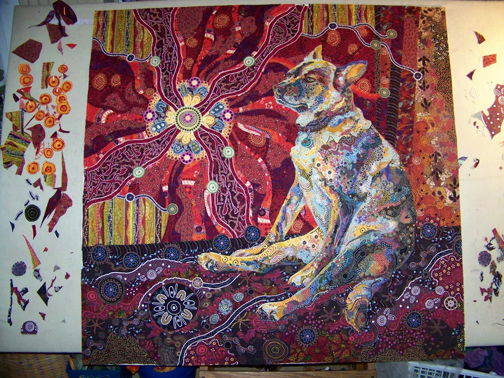
Houston
Not only was “Dixie Dingo Dreaming” accepted into the Houston exhibit, but it won first place in the “Good for You” exhibit. I traveled to Houston to accept the award, accompanied by my mother, Meta. In my short internet biography I say that I am a “long-time student of the Meta Carlson Studio of Fabric Creations,” e.g., my mom’s sewing room. Her strong influence on my life made it especially meaningful to have her there with me.

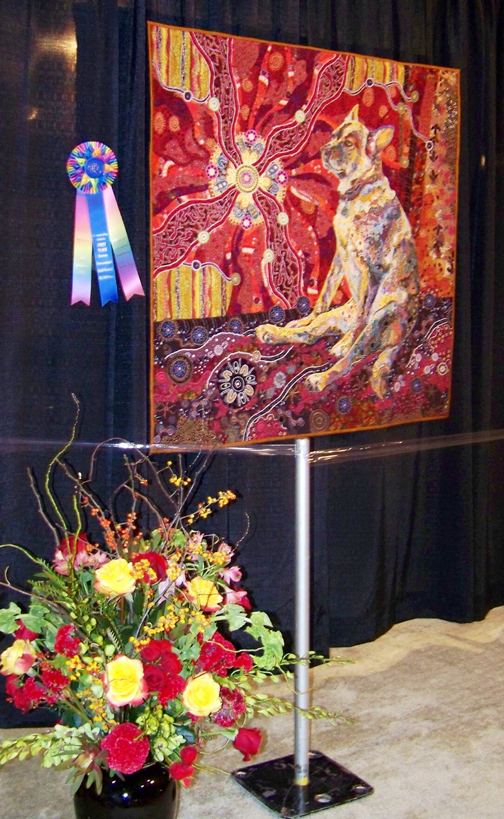
Symbolism
One of the few things I knew about Aboriginal art was that their images have layers of meaning. Unless you’re a part of that culture, you might not be privy to the deeper meaning of these abstracted shapes. However, the more superficial explanations are shared and I used these to create my own story of our own family in the background of the quilt.
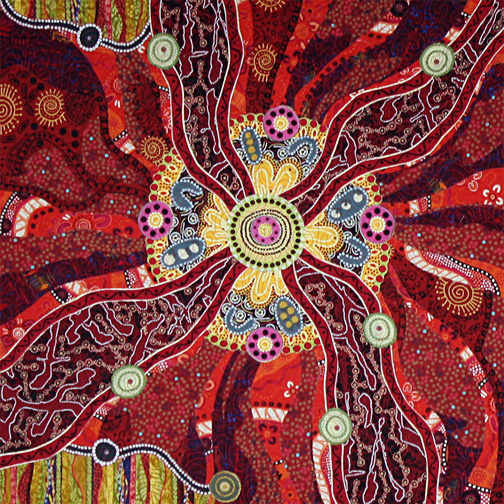
In the very center of the sun, concentric circles of dots represent a campfire in a village, similar to the fire pit in our lawn. Around the campfire are four blue-gray, U-shaped symbols. Those represent tribesmen, or the four of us: me, my husband, our son and the dog. Next to us are ovals with dots in them: baskets of food. There we are, around the campfire sharing a meal.
Wavy lines coming off from the inner circle represent journeys. So there are four main rays, one for each of us, that represent each of our journeys in life. When a smaller circle intersects one of the rays, that represents a pause in the journey. Someone pointed out to me that one of those journeys has two stops on it. “Well that must be your dog’s journey,” she said. Why? “She was someplace else before she came to you. So that’s hers. You became the second pause in her journey.”
The black and white horizontal wavy lines throughout the piece represent the journey of our cat Max, because he was an independent soul who wandered in and out of our lives, mostly coming in only for food and warmth, then wanting to be let back out.
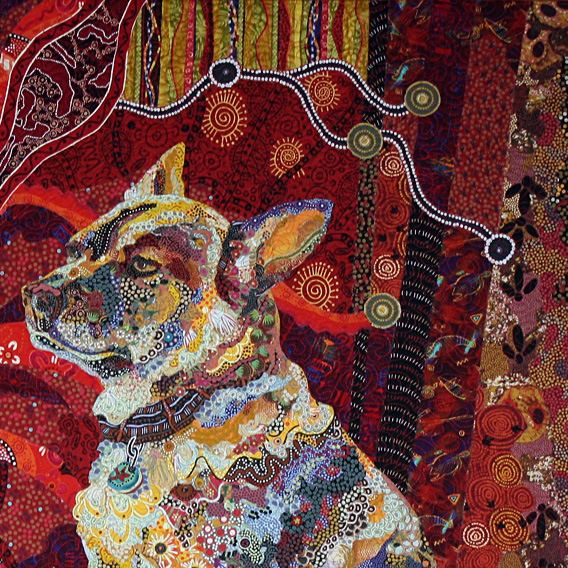
On the far right you see bird prints, which are supposed to be emu prints, but in our case represent our budgie Kiiora’s prints, which finishes the members of our family at that time. Not only are there footprints, but also eggs because she has laid dozens of (unfertilized) eggs in her lifetime.
So you see, “Dixie Dingo Dreaming” is a portrait of our dog, but it is also the story of our family at that time.
Serious Art
Does the sentiment on display (and hidden in its private symbols) in “Dixie Dingo Dreaming” prevent it from being “serious art”? I don’t know, but I do know that removing the sentiment from this piece, if you could do such a thing, would diminish it. I made it with love and when I look at it I remember the love Pippin gave me. I think that is clear to just about everybody who sees the piece.
Personally, I prefer art with heart. It takes guts for any artist, whether professional or novice, to lay out his or her feelings for others to examine, pore over, and critique. It takes courage to express sentiment, while it’s possible to hide behind being flip, detached, and ironic.
There was no irony in Pippin. She gave life her all. She devoured every biscuit she was offered. She tried to dominate every dog she met. She enjoyed every sunbeam and belly rub.
I call that serious art.
Live Online Classes Fall 2023
For more information on both classes, click here.
September 25-29, 2023
Live Online Fabric Collage ALL LEVELS Class with Susan Carlson–Animals Only
Class size is limited to 10 students.
$1,195
Subject matter limited to animals only. Suitable for all levels of students. Subjects limited to animals.
October 16-20, 2023
Live Online ADVANCED STUDENTS Class with Susan Carlson
Class size is limited to 8 students.
$1,495
In an advanced class we ask that a student have taken at least two classes or other fabric collage learning venues from Susan (e-Workshops, private coaching, Patreon Show-and-Share) so I have an idea if this level will be a good fit for you. If so, Tom will then send you a link to sign up for the class.
Facial Features eWorkshop
Click here for more information.
- Eight videos (over 8 hours combined length) collected into one convenient and organized spot
- Each annotated with “Jump Points” allowing you to scan forward and backward to the information you need
- Facial Features Templates included as PDF’s to download and work along with
- Like the Fabric Collage Online Master Class, membership in this eWorkshop is for life
$99
BUY NOW
(With a special Summertime offer good from now through August 31st, 2023)
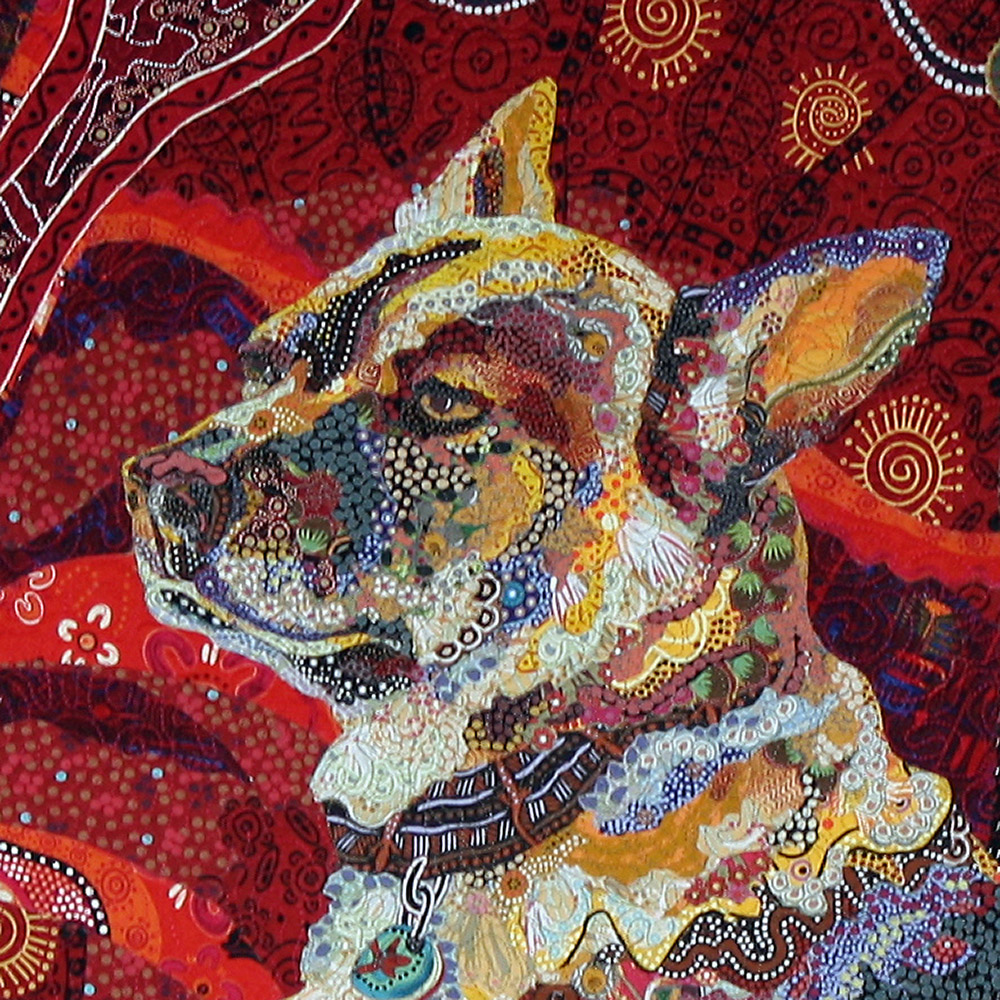
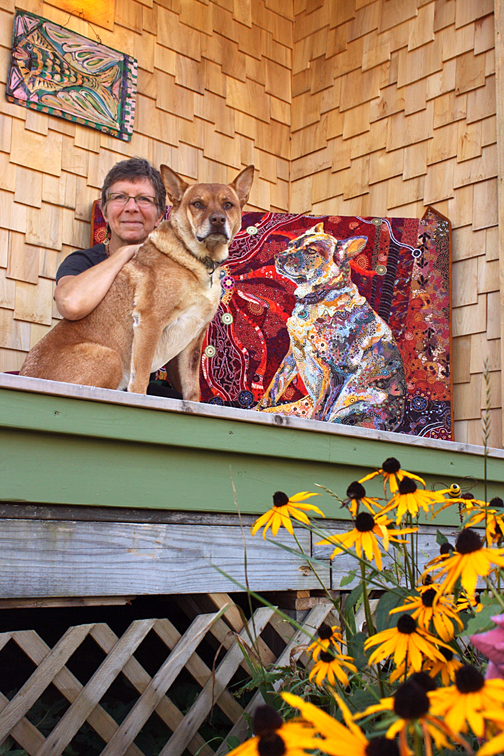





Loved the review of Pippenn the video regarding fabric choices in relation to your story was a good reminder. Thanks, Tom.
I’ve only been to Houston once and that was in 2011. I saw Susan’s quilt, Dixie Dingo, and just stood there. It was so wonderful! I took one of the postcards that was offered, brought it home and pinned it up over my desk. It’s still there and I look at it frequently.
It truly is a work of art from Susan’s heart.